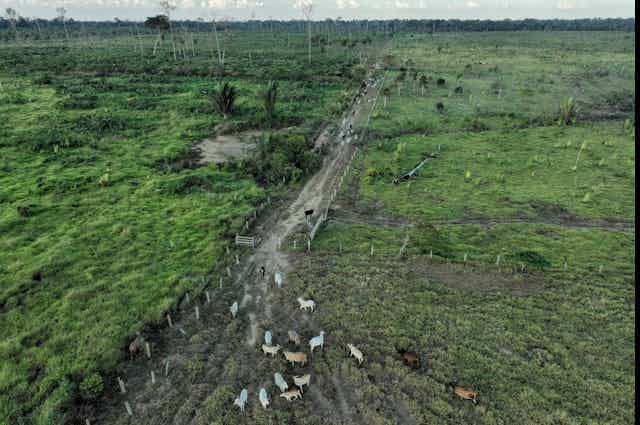According to Interpol, the organization dedicated to facilitating international police co-operation, between 15 per cent and 30 per cent of the world’s traded timber comes from illegal sources. This is an estimated annual value of US$51-152 billion dollars.
Illegal logging has serious consequences for the environment, the climate and the local livelihoods of the people who depend upon the affected forests. In turn, local governments are faced with losses in revenue, rising corruption and decreasing timber prices. These make it even more difficult for the legal forestry sector to remain competitive.
Read more: Illegal logging in Africa is a threat to security
Even in Canada, customers are unwittingly supporting this theft by buying timber with false declarations. In the face of such issues, Canadian researchers are currently developing a traceability system employing genomic identification technologies to help tackle the trade in illegal timber.
Stemming the flow
To help address poaching, the United States expanded the pre-existing Lacey Act in 2008. Originally designed to control the illegal trade of wildlife, it was adapted to help tackle the trade in illegally harvested wood. The 2008 amendments to the Lacey Act decreased the importation of illegally harvested wood into the U.S. by approximately 32 to 44 per cent.
In Canada, similar regulations have been put in place to avoid the exploitation of species at risk including the Wild Animal and Plant Protection and Regulation of International and Interprovincial Trade Act. But how do we know if the declarations of a wood product are accurate or correctly reported?

In general, identification methods can be categorized into three groups: anatomical, analytical or molecular biological techniques — each with its own set of advantages and limitations.
Identification methods which use the aid of microscope technology look for distinct characteristics of the wood anatomy including tissues and cells. It is also the group of methods most commonly used.
However, this method requires trained specialists, the appropriate equipment and can typically only provide meaningful conclusions at the genus level. In addition, wood anatomy cannot tell us where a piece of wood comes from.
Looking to genetics
This is where genomics come into play. To determine the species identity and the geographic origin of a logged tree, researchers take advantage of evolution.
A few key factors make genetic identification possible.
Firstly, there are clear genetic differences between distinct species. Secondly, the closer the relationship between individuals — in this case trees — the more genetically similar they are, while the more removed the individuals are the less genetic information is shared.
Therefore, it is possible to assign an individual to a “local population” based on its genetic fingerprint, sharing parts of its genetic makeup with that population and, consequently, also the specific region where it originates from. This method is called population genetics.
The power of population genetics lies in its ability to identify groups of individuals that share a certain amount of genetic information that can be used to assign individuals to a species or a geographic region. The same methods can be used for humans to find unknown relatives or trace back the ethnic origin of your ancestors.
Read more: Weakening Australia's illegal logging laws would undermine the global push to halt forest loss
To reliably assign individuals, a variety of genetic markers is needed, varying between species and local populations.
In Canada, the first successful use of genetic material to conduct forensic testing on trees was pioneered by geneticist Eleanor White who succeeded in tracing a wood log directly to the specific stump of an 800-year-old cedar tree in Western Canada left behind after its illegal felling.
White’s success demonstrates the power of genomic identification in regulating the timber trade.

Developing new systems
Genomic sequencing in combination with genetic data analyses gained public traction during the COVID-19 pandemic, as these were used to identify an outbreak of a new virus variant and trace its origin.
Current research in wood forensics is using similar tools to assign an individual to a source population with high accuracy. Since genetic analyses can be costly, genetic databases of previously studied species are compiled and used as test data to determine the best and most reliable analytical method.
The aim is to create a simple traceability system for timber products that border officials can implement quickly and easily. This should help stop the sale of illegally harvested timber and hold those responsible to account.
The long-term goal is to make it more difficult to sell illegally harvested timber in Canada and thus contribute to the protection of valuable forests. In addition, traceability can certify areas in Canada which are sustainably managed, making it easier for consumers to support sustainable forest management practices.

